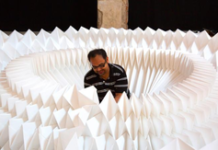SUKANT DEEPAK
New Delhi– With a view to celebrating 25 years of art, the New Delhi-based Threshold Art Gallery is presenting a solo show of Pandit Khairnar’s ‘Between Light and Shadow: Travels Through an Indian Landscape’ (on till May 1, 2022 — India Art Fair Parallel show).
The recent works on canvas and paper, travel a pathway of memories — feeling the sunshine and shadows of clouds cast on desert or mountains, the crisp cool morning air and hear the sound of a stream running. There is an intuitive feeling about the scale of his large paintings that encourage emotional memories.
Khairnar’s subtle, new graphite works on paper enforce skilful graduated tonal values using horizontal lines to create a strong sense of space and form. Though the horizontal lines suggest distance and calm, the broken lines express the ephemeral or the insubstantial. To be able to capture the sensitivity of a landscape with such an economy of means is not only a remarkable testament to the power of line as an expressive force but also an illustration of Khairnar’s outstanding drawing skills. His series of graphite studies leads the viewer
through a process of abstraction, refining form, tone and texture to extract the essence of his colour field painting using the pure line.
He builds the image layer upon layer until they establish a foreground with a dense tracery of lines and uses it as a device to pull your eye to the illusion of depth created by the work. It is abstract calligraphy of expressive lines drawn on the surface of the paper with an interaction between positive mass and negative space which heightens their spatial drama.
The artist says, “What is simple is really complex and this becomes visible for us and emerges only at a later stage, though one begins with this sense of something that’s only abstract in form. This becomes real to us only when it manifests into something cognitive but not necessarily a mirror image of what’s visible to the naked eye.”
The convincing techniques that Pandit uses, persuades the viewer to engage with the impossible search for rational meaning. He adapts his compositional approach to incorporate a grid-like arrangement, which not only offers him more control over the spatial organisation of his work but also referenced natural horizontals and verticals of the rural and urban landscapes. The influence of the grid underpins the composition of his paper works and gives him a point of reference from which to observe the effects of reconfiguring the elements of work over a series of images.
The artist stresses, “Art for me is an emotional response of my perception. Nature is always stable with its properties, but the visible changes are only outer. It is also a complete union of what I understand as a medium, matter, idea and intention of forming a harmonious relation, a narrative of human expression.” (IANS)
















